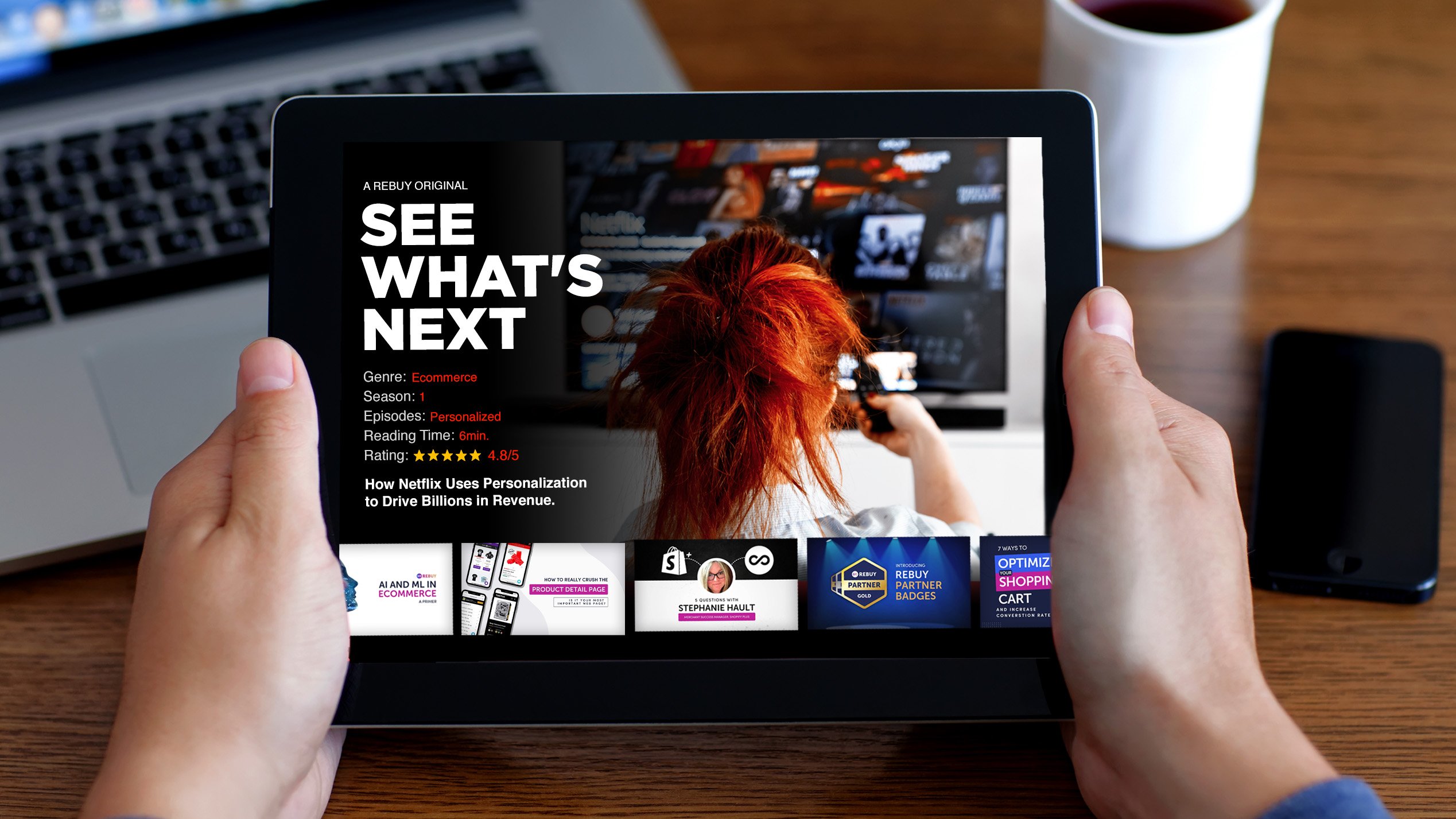If there’s one company that has revolutionized the customer experience, it’s Netflix.
Launched in 1997, the company began by selling and then renting DVDs and shipping them through the U.S. postal service to customers. In 2007, the company introduced streaming media and video on demand (VOD) using the power of its own personalization engine.
Through their unprecedented personalization algorithms, they have become one of the largest entertainment/media companies and last year ranked as the eighth most-trusted brand globally.
While the typical television show only has about a 35% chance of succeeding, Netflix’s original content is successful 93% of the time. That isn’t luck; it’s using the data and the powerful recommendation algorithms they have to get it in front of the right audience.

Behind The Red Curtain: Big Data, Analytics, and Personalization
Netflix’s “secret” isn’t actually a secret at all.
In 2017, Netflix stated that about 80% of watched content comes from the Netflix Recommendation Engine (NRE). Machine learning and their resulting predictive algorithms create “taste communities,” (i.e. clusters of people who have the same viewing habits and preferences), filtering over 3,000 titles and 1,300 recommendation clusters at a time for 195M+ members in over 190 countries.
The more you watch, the more data is collected to sort groups and develop more accurate predictions. These algorithmic preferences and predictions are what you see displayed on your unique homepage or hyper-personalized profile, making it easier and faster for Netflix users to find what they want.
Here’s how the “magic” happens.
Advanced Search Algorithms & Page Personalization
Much of Netflix’s algorithm is dependent on getting the right titles in front of the right customer at the right time.
For a popular example, let’s use “The Crown,” a dramatization of the reign of Britain’s longest-ruling monarch, Queen Elizabeth II. If you watched this show all the way through, your profile would be broken down into categories based on this choice. Your search algorithms may reflect that you preferred “strong female leads,” “period dramas,” “shows for anglophiles,” and other shows with Olivia Coleman (who portrayed Queen Elizabeth II). Recommendations may include other Netflix shows such as “Bridgerton,” “Broadchurch,” or “The Great British Baking Show.”
However, these choices are based on thousands of data points collected by Netflix subscribers. Other data points that Netflix collects to create highly personalized product recommendations include (but are not limited to):
- User profile information (including age, gender, language, location, and self-reported content interests)
- Time and date user watched a title
- Type of device used to stream
- Watch patterns (whether a show was paused, rewound, fast-forwarded)
- Whether an entire movie or TV series was completed
- Number of searches and what was searched for
- Browsing history
-jpg.jpeg) These thousands of data points on customers significantly improve customer recommendations, reduce churn rate, and ensure customer loyalty, boosting the company’s ROI.
These thousands of data points on customers significantly improve customer recommendations, reduce churn rate, and ensure customer loyalty, boosting the company’s ROI.
Messaging and Marketing Personalization
Netflix personalization doesn’t end there. The company also uses deep learning tools to indicate why that product is right for you and why it’s worth watching. One avenue they use to create effective messaging is via images and videos. Content containing images or videos receives 94% more views, so Netflix knows that these are high-impact marketing pieces upon which to focus personalization.
Netflix uses image recognition to target user behavior for both product development and marketing and creates targeted marketing campaigns for their original content. Image recognition stores, analyzes, and personalizes still images and images within videos that you prefer, watch, and rewatch. That means their deep machine learning engine can parcel out and codify objects in scenes, moods, and genres that you are frequently attracted to and use personalized artwork in marketing to you. 🤯
Let’s consider the classic film “Forrest Gump.” How this one film is recommended is based on a variety of genres and themes. Someone who is a romance buff may be more interested in Forrest Gump if the artwork shown contains Tom Hanks and Robin Wright. In contrast, someone who has tendencies to watch nostalgic films made in the ‘90s may be more attracted to iconic scenes, such as Forrest Gump on that park bench with his box of chocolates.
-jpg.jpeg)
Similarly, preferences for certain actors can determine different artwork. A Marlon Brando fan would more likely choose “The Godfather” with a cameo of Brando in the artwork while someone who tends to watch films with Al Pacino would more likely choose the film with Pacino in the artwork.
Netflix’s landing cards are an example of how Netflix uses image and video recognition to market its original content and product discovery. Landing cards are images or video trailers visible to users browsing through recommendations. Netflix’s data allows them to understand the psychology of customers and, in turn, they can personalize customer experiences with these landing cards.
Each of Netflix’s original content pieces has over 10 different trailers cut for content that they expect to be popular. They use these trailers to put in landing cards for customers with matching preferences, ensuring that personalized recommendations and personalized visuals are used for the intended audience.
Personalization for a More Discerning Buyer
Netflix isn’t the only company using personalization. Other online shopping or streaming giants such as Amazon, Spotify, LinkedIn, Instagram, and YouTube all have highly powered recommendation engines. These AI-powered engines process terabytes of data to learn more about customer preferences and generate meaningful product recommendations, boost product discovery in front of the appropriate audience, and ensure customer retention and customer lifetime value (LTV).
Netflix's personalization is the reason for its success. It's ability to collect data, personalize product recommendations, and personalize messaging is second to none. According to Netflix, they earn over a billion dollars in customer retention revenue annually because of their advanced analytics and modeling capabilities.
Research shows the retail market is in for a wild ride in the next couple of years. With mounting costs and less disposable income, consumers have become more discerning. According to McKinsey research, “Most industry forecasts suggest that US retail growth over the next five years will average 3 to 4 percent annually, well below the 5 to 7 percent yearly growth seen in the decade prior to the recession.”
The Future of Ecommerce is Personalized
How will digital retailers keep up? Predictions align with what some of the largest online retailers are already doing: hyper-personalization. Amazon already generates 35% of its revenue from recommendation engines, and Netflix reports that anywhere from 75% to 80% of its revenue is generated through extremely personalized algorithms that keep viewers coming back for more.
If you’re interested in using personalization to generate unique experiences for your customers, take a look at what Rebuy can do for you. We power some of the top digital retail businesses and can leverage the same tools for your store.
•••
Try Rebuy free and see why the world’s top brands use Rebuy to accelerate sales growth.
Interested in partnering with Rebuy? Let's do it.
To keep up with the latest trends, platform updates, and more, follow us on LinkedIn.
